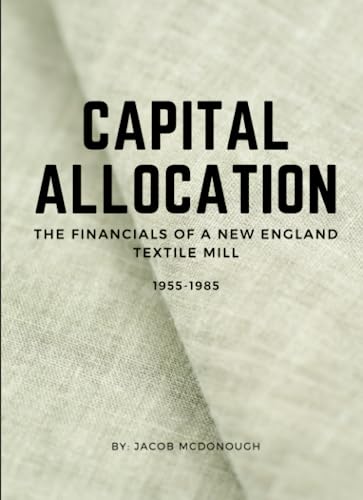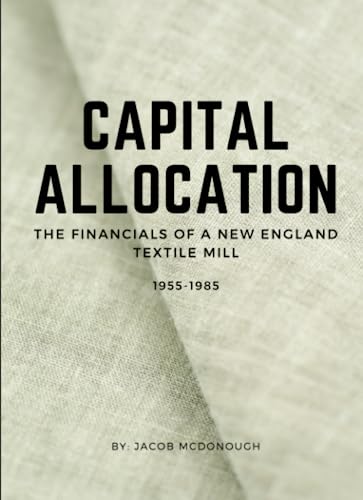Capital Allocation: The Financials of a New England Textile Mill 1955 – 1985 is a comprehensive study that examines the financial aspects of a textile mill operating in New England from 1955 to 1985. This book provides a detailed analysis of how capital was allocated in the mill during this significant period of time, shedding light on the financial decisions that shaped its growth and success. It explores the strategies employed by the mill's management to allocate resources effectively, including investments in technology, machinery, and workforce development. Additionally, the book delves into the economic factors that influenced capital allocation, such as market conditions, competition, and government policies. Through meticulous research and data analysis, this study offers valuable insights into the financial management practices of the New England Textile Mill and their impact on its long-term performance. Overall, Capital Allocation: The Financials of a New England Textile Mill 1955 – 1985 provides a comprehensive understanding of the capital allocation process in the context of a prominent textile mill in New England during a crucial period of its history.
Capital Allocation: The Financials of a New England Textile Mill 1955 – 1985
Capital allocation is a crucial aspect of financial management for any business, and the case of a New England textile mill during the period of 1955 to 1985 provides valuable insights into this process. This article delves into the financials of the mill, highlighting two compelling aspects of its capital allocation strategy.
The Importance of Long-Term Investments
During this time period, the New England textile mill recognized the significance of making long-term investments to ensure sustainable growth. They allocated a significant portion of their capital towards modernizing machinery and expanding their production capacity. This strategic decision enabled the mill to keep up with technological advancements and remain competitive in the industry. By investing in state-of-the-art equipment, they were able to increase efficiency, reduce labor costs, and ultimately improve their bottom line. This approach not only secured the mill's position in the market but also allowed them to meet growing consumer demands.
Diversification and Risk Management
An important aspect of capital allocation for the New England textile mill was diversification. Recognizing the volatility of the textile industry, they strategically diversified their investments, spreading their capital across various sectors. By doing so, they mitigated the risk of being overly reliant on a single segment. This approach allowed them to navigate economic downturns and industry fluctuations more effectively. Furthermore, diversification provided the mill with opportunities to explore new markets and expand their customer base. By allocating capital to different areas, they were able to adapt to changing consumer preferences and capitalize on emerging trends.
In conclusion, the financials of the New England textile mill between 1955 and 1985 demonstrate the importance of long-term investments and diversification in capital allocation. These strategies played a vital role in the mill's success, enabling them to weather industry challenges and achieve sustainable growth. By focusing on modernization and diversification, the mill exemplified sound financial management practices that can provide valuable lessons for businesses even today.
“Capital Allocation in a New England Textile Mill: 1955-1985 Financial Analysis”
ASIN: B088B96JRK
Publisher: Independently published (May 9, 2020)
Language: English
Paperback: 199 pages
ISBN-13: 979-8631760202
Item Weight: 9.9 ounces
Dimensions: 6 x 0.5 x 8.27 inches



